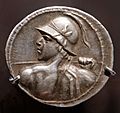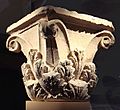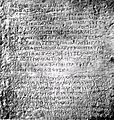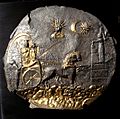Greco-Bactrian Kingdom facts for kids
Imagine a kingdom far, far away, at the edge of the ancient Greek world! This was the Greco-Bactrian Kingdom. It existed for about 125 years, from 250 BC to 125 BC. This kingdom was located in a region that Alexander the Great had conquered earlier. It covered most of modern-day Afghanistan. It also included parts of Turkmenistan, Iran, and Pakistan.
Most of what we know about this kingdom comes from old writings. A Roman writer named Strabo shared many details. Also, archaeologists have found many clues. They have dug up ancient cities in Afghanistan. Two important sites are Aï Khanoum and Begram. These digs help us understand how people lived back then.
Discovering the Greco-Bactrian Kingdom
Many amazing things from the Greco-Bactrian Kingdom have been found. Some of these discoveries are shown in special exhibits.
Museum Exhibitions
The National Museum of Afghanistan has created a traveling exhibition. This show has visited famous museums around the world. It has been seen at the British Museum in London. It has also traveled to France, Germany, and the Netherlands. You can also see many other ancient items from this kingdom. They are on display at the Hermitage Museum in St. Petersburg, Russia. These exhibits help us learn about this fascinating ancient kingdom.
Images for kids
-
Remains of a Hellenistic capital found in Balkh, ancient Bactra.
-
Coin depicting the Greco-Bactrian king Euthydemus 230–200 BC. The Greek inscription reads: ΒΑΣΙΛΕΩΣ ΕΥΘΥΔΗΜΟΥ – "(of) King Euthydemus".
-
Silver tetradrachm of King Eucratides I 171–145 BC. The Greek inscription reads: ΒΑΣΙΛΕΩΣ ΜΕΓΑΛΟΥ ΕΥΚΡΑΤΙΔΟΥ – "(of) King Great Eucratides".
-
The migrations of the Yuezhi through Central Asia, from around 176 BC to AD 30
-
Silver coin of Heliocles (r. 150–125 BC), the last Greco-Bactrian king. The Greek inscription reads: ΒΑΣΙΛΕΩΣ ΔΙΚΑΙΟΥ ΗΛΙΟΚΛΕΟΥΣ – "(of) King Heliocles the Just".
-
Corinthian capital, found at Ai-Khanoum, 2nd century BC
-
Stone block with the inscriptions of Kineas in Greek. Ai Khanoum.
-
Indian coinage of Agathocles, with Buddhist lion and dancing woman holding lotus, possible Indian goddess Lakshmi.
-
Silver drachm of Menander I, dated circa 160–145 BC. Obverse: ΒΑΣΙΛΕΩΣ ΣΩΤΗΡΟΣ ΜΕΝΑΝΔΡΟΥ ('of King Menander the Saviour'), heroic bust of Menander, viewed from behind, head turned to left; Reverse: Athena standing right, brandishing thunderbolt and holding aegis, Karosthi legend around, monogram in field to left.
-
Plate depicting Cybele pulled by lions. Ai Khanoum.
-
Head of a Greco-Bactrian ruler with diadem, Temple of the Oxus, Takht-i Sangin, 3rd–2nd century BCE. This could also be a portrait of Seleucus I.
See also
 In Spanish: Reino grecobactriano para niños
In Spanish: Reino grecobactriano para niños




























